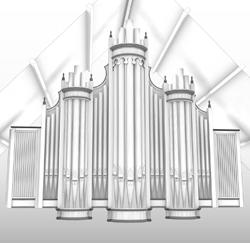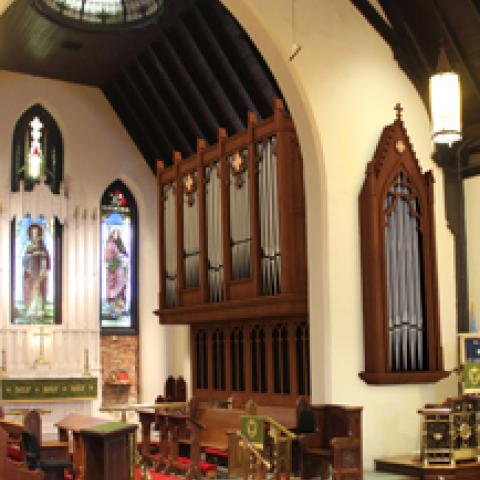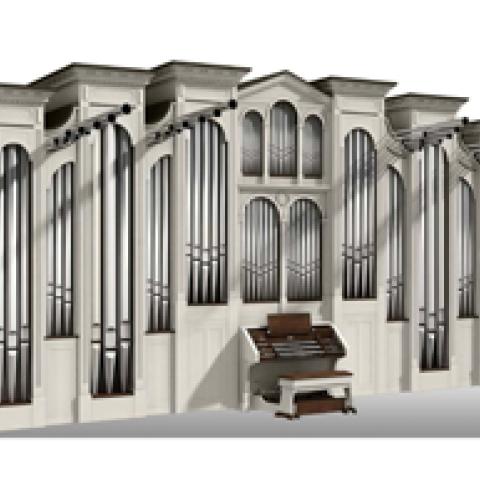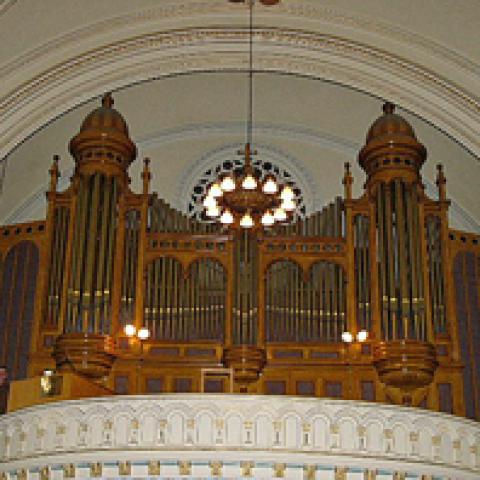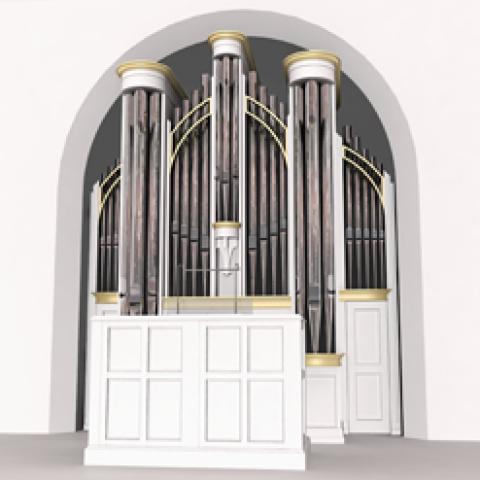From the organbuilder
In their search for an organbuilder, Memorial Presbyterian Church identified an ability to lead hymn singing as a priority for their new instrument. The accompaniment of the church’s choir and the needs of the organ repertoire were important but less significant considerations; this pipe organ’s raison d’être was to support a large congregation in song. As a result, our Opus 122 was designed to offer the perceptive player a wide array of colors and textures for leading hymns and word painting.
Given in memory by her brother Charles, the Bertha E.R. Strosacker Memorial Presbyterian Church was thet work of New York City architect Aymar Embury II (1880–1966), who regarded the church as one of his finest designs. The building was opened in 1953 and displays Embury’s unique style that defies easy categorization as classical or Georgian. The exterior of the building is handsome in a way that belies its size; the 172-foot-tall tower can, however, be seen from nearly anywhere in Midland. Inside, the long church sanctuary is similarly understated, with natural light playing a striking role through large floor-to-ceiling windows and crisp white surfaces.
Prior to beginning the organ project, the church was acoustically unremarkable; the apse-like chancel area, the chancel arch and the rectilinear surfaces of the nave presented challenges for the proper transmission of sound without confusing reflections and echoes. The church wisely engaged in the services of acoustician Scott Riedel, who recommended adding visually subtle diffusers to various surfaces throughout the sanctuary; these improvements were realized before the new organ’s installation.
The original organ chambers were on both sides of the chancel arch, with each chamber having tone openings to the chancel and nave. Their most commented-upon feature was the four grilles that fronted each opening and displayed favorite hymn tunes on treble and bass staves. As the new organ is considerably larger than its predecessor, the existing chambers were expanded laterally to sweep around the chancel’s semi-circular back wall. While the old chambers’ tone openings and grilles were maintained, the new chambers display speaking pipes from the Great diapasons, the Pedal 8′ Principal, and the second octave of the Pedal 16′ Open Diapason; the relatively unadorned arrangement of the pipes and their restrained finish were intended to quietly complement the chancel without drawing undue attention.
With openings to the nave and the chancel, the original chambers allowed us to design the organ such that organists have a choice with respect to the amount of sound projected to the nave. To restrict tone to the chancel for accompanying, the Swell and Choir nave shades can be closed via drawknobs. Used judiciously, these shades can also be kept closed for climactic moments as the instrument presents a markedly broader sound field in the nave when the nave shutters are open.
In preparing the specification for Opus 122, we evaluated the pipework from the church’s previous Austin organ with an eye to reusing the best ranks as a measure of stewardship. Several partial ranks made the cut: the first 32 pipes of the Great 16′ Violonbass and another 32 pipes from the present Great 8′ Harmonic Flute were restored and revoiced in addition to the Swell 16′-8′-4′ reed chorus. In the Choir division, the bass octave of the 16′ Dulciana and all 54 pipes from the Solo 8′ Flute Celeste rank were also reused. Finally, the bass octave of the Pedal 16′ Open Diapason—comprising usefully slender open wood pipes—and 32 pipes from the Pedal 16′ Trombone were successfully reworked into the new instrument.
The Létourneau organ at Memorial Presbyterian Church is an excellent example of our tonal goals, with a wide array of elegant colors and clear chorus structures. The tonal design also follows certain other recent Létourneau instruments in which the Swell and Great divisions are almost evenly matched dynamically. Despite five 8′ flues and fifteen ranks in total, the full Great maintains a clean, placid nature that brings to mind some of the better American Classic examples from the early 1950s. The Swell is luxurious in its size and scope, with the full Swell properly driven by reed tone to color the Great division. The versatile Choir has a number of softer combinations but can also take on a substantial role in the build up to full organ as with a French Positif division. Duplication of tone between the Swell and Choir has been avoided through careful scaling and other pipe construction details; the Choir’s two-rank Sesquialtera is composed of principal-toned pipes to contrast with the Swell’s fluty cornet décomposé. Likewise, the Choir’s two reed stops—an 8′ Trumpet and an 8′ Cromorne—have an unambiguous French timbre that takes over where the Swell’s smoother reed chorus leaves off. The expressive Solo division offers a harmonic 8′ Concert Flute in wood, an otherworldly two-rank 8′ Flute Celeste and two orchestral-style reeds, plus a high-pressure 8′ Tuba with Willis-style shallots. With 32′ flue and reed ranks—plus a 16′ extension of the Solo Tuba sounding on 15 inches of wind—the full resources of the Pedal division are impressive to behold, yet an abundance of lesser sonorities to balance the manuals is available as well.
The handsome four-manual console resides on a rolling platform for mobility within the chancel and has a number of conveniences to help manage the instrument’s resources. In addition to the Nave Shutters Closed drawknobs within the Swell and Choir divisions, there is an All Swells to Swell feature, with all of these controls programmable on the General pistons as required. Other refinements include discreet thumb pistons for page-turners to operate the General piston sequencer and a manual transfer function, exchanging the Great and Choir manuals to ease the playing of French Romantic repertoire.
The timeline for this project—from initial contact to the dedicatory concerts—spanned over five years, and we remain grateful to Memorial Presbyterian Church for entrusting us to build this grand and complex musical instrument. Over the years, it was a particular privilege to work with Memorial’s Director of Music and the Arts, Guy Lynch, who ably supervised the project on the church’s behalf. Others who contributed greatly to the success of the Opus 122 include William Clisham (Memorial’s organ consultant), Dr. Adrienne Wiley (organist at Memorial), Ivan Wood (facilities manager at Memorial), and David Morrison (the organ project’s unofficial photographer).
—Andrew Forrest, Artistic Director
Fernand Létourneau, President
W. Dudley Oakes, Project Consultant
From the director of music
Opus 122 from Orgues Létourneau Limitée has, since its completion, delighted organists and congregations each week. While Memorial Presbyterian Church wanted a new pipe organ that worked well for choral accompaniment and for solo recitals, it primarily sought a stoplist and design that would unfailingly support congregational singing, providing worshippers with a sense of support and propulsion without being overwhelming.
New chambers surrounding the chancel were constructed for the Great and Pedal divisions, and in keeping with the architectural symmetry of the sanctuary, the design of the façade pipes in four bays allowed for two different Great 8′ diapason ranks. Each has its own color and strength, and either can sit equally well under the chorus; when combined, the effect is a substantial foundation, but not an overwhelming one. They offer a valuable clarity of speech that makes articulated passagework sound clean, yet the legato never seems to suffer. The Great principal chorus possesses the distinctive, clear character one would expect and supports congregational singing with great transparency, a word often used in our conversations with Létourneau.
Throughout the organ’s expressive divisions, the extraordinary thickness and density of the swell shades yield a usefully wide range of dynamics; some of the softer string and flute stops almost disappear completely when the shades close. The Swell and Choir divisions have shades on two sides of their boxes, opening towards both the chancel and to the nave, and organists can choose to leave the nave shades closed if accompanying a choir singing in the chancel, for example.
The Solo division’s six ranks are perhaps the instrument’s most distinctive. The strong 8′ Tuba can sit atop a very full accompanying registration with ease and balance. The flute stops are exquisite: the wooden 8′ Concert Flute has a delightfully realistic orchestral timbre, while the combination of the 8′ Dolce Flute and the 8′ Flute Celeste was described as “too sinful to be used during worship.” Throughout the remaining manual divisions, the instrument’s ability to create a sense of ensemble seems unfailingly consistent and even unconventional registrations can yield delicious results. Mutation stops on all the manuals are colorful and well balanced, with several unison and octave combinations in support.
The extensive Pedal division supplies the organist with useful choices: While the Pedal stops undergird manual registrations in a very satisfying way, they also speak clearly and quickly—the capable organist can keep even the sleepiest churchgoer up to tempo. The Pedal 16′ Open Diapason’s speech is particularly clean and most distinct.
Organists have found Opus 122’s console to be comfortable and easy to use; its toe pistons are accessible to even the shortest pair of legs. The music desk can slide toward the organist over the Solo manual, a useful feature when reading glasses have gone missing!
The congregation’s support of the organ project was remarkable in this writer’s experience, and their input was sought and nurtured throughout the proposal phase. Members and friends were encouraged to visit the organ committee’s information display to view Létourneau’s drawings and communications; the displays were changed almost each week. Once the organ project was approved by the church’s leadership, Létourneau supplied photographs that kept the congregation informed and enticed during the typical lull between contract signature and completion. Parishioners even lent quilts and blankets to cover the sanctuary’s pews for the organ’s delivery; some seventy volunteers unloaded the truck and transformed the sanctuary into a dauntingly large warehouse of pipework, chests, and windways.
Opus 122 was, to a wonderful degree, funded by dollars that came from community sources, and because the campaign to pay for the organ was so oversubscribed, Memorial Presbyterian Church used those extra dollars to provide financial support to important local and distant mission causes. The church is intentional about making the instrument accessible for community purposes and important improvements to the sanctuary’s acoustics have made the church even more attractive to community music makers. British organist David Baskeyfield performed two inaugural recitals on Opus 122 to comfortably large crowds made up from congregation and community members in September of 2012. The dedication committee worked with Mr. Baskeyfield to offer a program that included mainstays of the organ repertoire during the first half and an improvised accompaniment of the silent film The Phantom of the Opera to conclude. The result was a meaningful and delightful evening that attracted many who otherwise would have not attended the inaugural concerts.
The people at Létourneau—to the person—possess an unfaltering zeal for their art. The friendliness, attention to detail, flexibility, and stellar professionalism consistently shown to Memorial Presbyterian Church have been and continue to be a blessing.
—Guy A. Lynch
Director of Music and the Arts
All photos courtesy of David Morrison Photography
